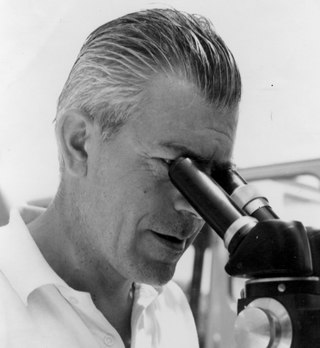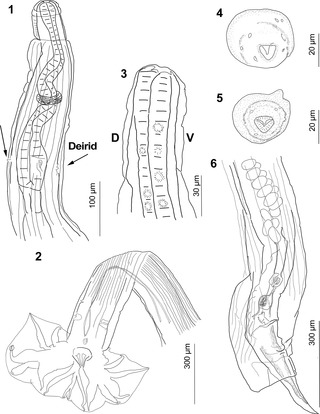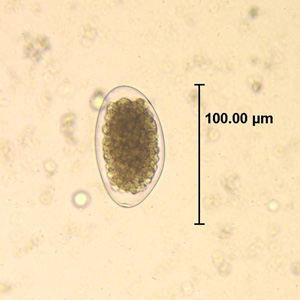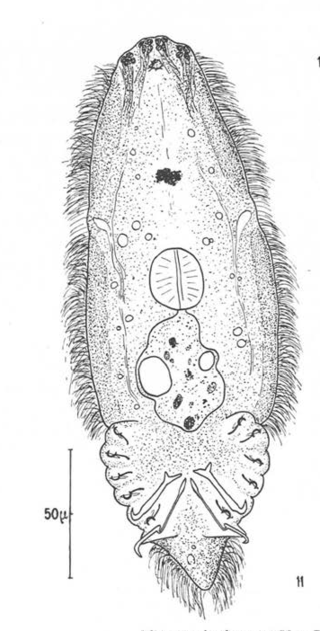
The Strongylida suborder includes many of the important nematodes found in the gastrointestinal tracts of ruminants, horses, and swine, as well as the lungworms of ruminants and the hookworms of dogs and cats.

Gongylonema is a genus of thread-like nematode that was described by Molin in 1857. It is the only currently valid genus in the family Gongylonematidae, though the mysterious Spiruroides – usually placed in the Subuluridae, which are not closely related to Gongylonema among the Spiruria – might actually belong here. They are parasites of birds and mammals, transmitted by insects. Some 38 species are known, about 12 of which have been recorded in Europe.
Plasmodium cyclopsi is a parasite of the genus Plasmodium subgenus Vinckeia.

The Ascarididae are a family of the large intestinal roundworms. Members of the family are intestinal parasites, infecting all classes of vertebrates. It includes a number of genera, the most well known of which are:

Onchocerca is a genus of parasitic roundworm. It contains one human parasite – Onchocerca volvulus – which is responsible for the neglected disease Onchocerciasis, also known as "river blindness" because the infected humans tend to live near rivers where host black flies live. Over 40 million people are infected in Africa, Central America, and South America. Other species affect cattle, horses, etc.
Tetrameridae is a family of spirurian nematodes. It is the smallest of the large genera making up the bulk of the superfamily Habronematoidea. Like all nematodes, they have neither a circulatory nor a respiratory system. They are parasites, chiefly of birds and cetaceans.

The Onchocercidae are a family of nematodes in the superfamily Filarioidea. This family includes some of the most devastating human parasitic diseases, such as lymphatic filariasis, onchocerciasis, loiasis, and other filariases.

Hassalstrongylus is a genus of nematode worms that infect mostly muroid rodents from eastern North America to South America. The genus is part of the Heligmonellidae and related to genera like Stilestrongylus.
Hassalstrongylus lichtenfelsi is a nematode worm of the genus Hassalstrongylus that infects the marsh rice rat in Florida. The females cannot be distinguished from those of the other species in the marsh rice rat, H. forresteri and H. musculi.

Pterygodermatites is a genus of parasitic nematodes in the family Rictulariidae. Their life-cycle is complex. Species include:
Durikainema is a genus of two nematodes in the family Robertdollfusiidae. Species have a head with a cuticular cephalic inflation, elongated papillae and amphids, and well-developed musculature. Characteristics of the males include a single spicule and a long attenuated tail. Durikainema species parasitize macropods. The genus was circumscribed in 1982 with the type species Durikainema macropi, a parasite of the eastern grey kangaroo. D. phascolarcti, parasite of the koala, was described in 1998.

Alain Chabaud was a French parasitologist, mainly a specialist of nematodes and sporozoa. He was the Director of the Laboratoire de Zoologie (Vers) in the Muséum National d'Histoire Naturelle in Paris from 1960 to 1989. He was one of the founders of the Société Française de Parasitologie in 1962 and its president until 1975, and president of the Société zoologique de France in 1967.

Odilia is a genus of nematode worms established by Marie-Claude Durette-Desset in 1973 that infect mostly murid rodents of the Australasian region (species of Melomys, Rattus and Uromys from mainland Australia and Tasmania.

Guerrerostrongylus is a genus of nematode worms. Species of Guerrerostrongylus infect mostly the digestive tract of sigmodontine and caviomorph rodents from South America. The genus is part of the subfamily Nippostrongylinae.

Trichostrongylidae is a family of nematode in the suborder Strongylida.

František Moravec is a Czech parasitologist who specialises on the Nematodes, especially the nematodes parasites of fishes. His research is mainly in the field of taxonomy of the Nematoda.

Cystidicolidae is a family of spirurian nematodes. It was described by Skrjabin in 1946. All members of the family are parasites of fish.

An oncomiracidium is the ciliated and free-living larva of a monogenean, a type of parasitic flatworm commonly found on fish. It is similar to the miracidium of Trematoda, but has sclerotised (hardened) hooklets not found in the latter.

Robert-Philippe Dollfus was a French zoologist and parasitologist.

Hassalstrongylus dollfusi is a nematode worm of the genus Hassalstrongylus, first described under the name Longistriata dollfusi by Carlos Díaz-Ungría in 1963 who named it dollfusi as an homage to French parasitologist Robert-Philippe Dollfus. The species was transferred to the genus Hassalstrongylus in 1971 by Marie-Claude Durette-Desset. Serrano et al. redescribed the species in 2021.















